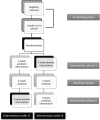Influence of habitual dietary fibre intake on the responsiveness of the gut microbiota to a prebiotic: protocol for a randomised, double-blind, placebo-controlled, cross-over, single-centre study
- PMID: 27591024
- PMCID: PMC5020659
- DOI: 10.1136/bmjopen-2016-012504
Influence of habitual dietary fibre intake on the responsiveness of the gut microbiota to a prebiotic: protocol for a randomised, double-blind, placebo-controlled, cross-over, single-centre study
Abstract
Introduction: The commensal gut microbiota have been shown to have an impact on human health as aberrant gut microbiota have been linked to disease. Dietary constituents are influential in shaping the gut microbiota. Diet-specific therapeutic strategies may therefore play a role in optimising human health via beneficial manipulation of the gut microbiota. Research has suggested that an individual's baseline gut microbiota composition may influence how the gut microbiota respond to a dietary intervention and individuals with differing habitual dietary intakes appear to have distinct baseline gut microbiota compositions. The responsiveness of the gut microbiota may therefore be influenced by habitual dietary intakes. This study aims to investigate what influence differing habitual dietary fibre intakes have on the responsiveness of the gut microbiota to a prebiotic intervention.
Methods and analysis: In this randomised, double-blind, placebo-controlled, cross-over, single-centre study, 20 low dietary fibre (dietary fibre intake <18 g/day for females and <22 g/day for males) and 20 high dietary fibre (dietary fibre intake ≥25 g/day for females and ≥30 g/day for males) consumers will be recruited. Participants will be randomised to a placebo (Glucidex 29 Premium) or a prebiotic (Synergy 1) intervention for 3 weeks with a 3-week washout followed by 3 weeks of the alternative intervention. Outcome measures of gut microbiota composition (using 16S rRNA gene sequencing) and functional capacity (faecal short chain fatty acid concentrations and Phylogenetic Investigation of Communities by Reconstruction of Unobserved States (PICRUSt)) as well as appetite (visual analogue scale appetite questionnaire) will be assessed at the beginning and end of each intervention phase.
Ethics and dissemination: The Massey University Human Ethics Committee approved this study (Massey University HEC: Southern A application-15/34). Results will be disseminated through peer-review journal publications, conference presentations and a summary of findings will be distributed to participants.
Trial registration number: ACTRN12615000922572; Pre-results.
Keywords: 16S rRNA gene sequencing; Appetite; Gut microbiota; NUTRITION & DIETETICS; Prebiotic.
Published by the BMJ Publishing Group Limited. For permission to use (where not already granted under a licence) please go to http://www.bmj.com/company/products-services/rights-and-licensing/
Conflict of interest statement
Figures


Similar articles
-
Habitual dietary fibre intake influences gut microbiota response to an inulin-type fructan prebiotic: a randomised, double-blind, placebo-controlled, cross-over, human intervention study.Br J Nutr. 2018 Jan;119(2):176-189. doi: 10.1017/S0007114517003440. Epub 2018 Jan 8. Br J Nutr. 2018. PMID: 29307330 Clinical Trial.
-
Does Fibre-fix provided to people with irritable bowel syndrome who are consuming a low FODMAP diet improve their gut health, gut microbiome, sleep and mental health? A double-blinded, randomised controlled trial.BMJ Open Gastroenterol. 2020 Aug;7(1):e000448. doi: 10.1136/bmjgast-2020-000448. BMJ Open Gastroenterol. 2020. PMID: 32816830 Free PMC article. Clinical Trial.
-
Prebiotic effects of diet supplemented with the cultivated red seaweed Chondrus crispus or with fructo-oligo-saccharide on host immunity, colonic microbiota and gut microbial metabolites.BMC Complement Altern Med. 2015 Aug 14;15:279. doi: 10.1186/s12906-015-0802-5. BMC Complement Altern Med. 2015. PMID: 26271359 Free PMC article.
-
Effect of fructans, prebiotics and fibres on the human gut microbiome assessed by 16S rRNA-based approaches: a review.Benef Microbes. 2020 Mar 27;11(2):101-129. doi: 10.3920/BM2019.0082. Epub 2020 Feb 19. Benef Microbes. 2020. PMID: 32073295 Review.
-
Designing future prebiotic fiber to target metabolic syndrome.Nutrition. 2014 May;30(5):497-502. doi: 10.1016/j.nut.2013.08.013. Epub 2013 Oct 2. Nutrition. 2014. PMID: 24262515 Review.
Cited by
-
The gut microbiome as a target for prevention and treatment of hyperglycaemia in type 2 diabetes: from current human evidence to future possibilities.Diabetologia. 2017 Jun;60(6):943-951. doi: 10.1007/s00125-017-4278-3. Epub 2017 Apr 22. Diabetologia. 2017. PMID: 28434033 Free PMC article. Review.
-
Impact of violacein from Chromobacterium violaceum on the mammalian gut microbiome.PLoS One. 2018 Sep 13;13(9):e0203748. doi: 10.1371/journal.pone.0203748. eCollection 2018. PLoS One. 2018. PMID: 30212521 Free PMC article.
-
The Moderating Role of Dietary Quality and Dietary Fibre Intake on the Mood Effects of Positive Expressive Writing: A Pilot Study.Nutrients. 2024 Aug 27;16(17):2875. doi: 10.3390/nu16172875. Nutrients. 2024. PMID: 39275190 Free PMC article. Clinical Trial.
-
Probiotics and Prebiotics as Dietary Supplements for the Adjunctive Treatment of Type 2 Diabetes.Pol J Microbiol. 2023 Mar 24;72(1):3-9. doi: 10.33073/pjm-2023-013. Print 2023 Mar 1. Pol J Microbiol. 2023. PMID: 36929892 Free PMC article.
References
-
- Candela M, Perna F, Carnevali P, et al. . Interaction of probiotic Lactobacillus and Bifidobacterium strains with human intestinal epithelial cells: adhesion properties, competition against enteropathogens and modulation of IL-8 production. Int J Food Microbiol 2008;125:286–92. 10.1016/j.ijfoodmicro.2008.04.012 - DOI - PubMed
Publication types
MeSH terms
Substances
Associated data
LinkOut - more resources
Full Text Sources
Other Literature Sources
Medical
